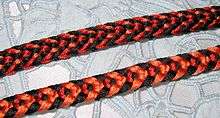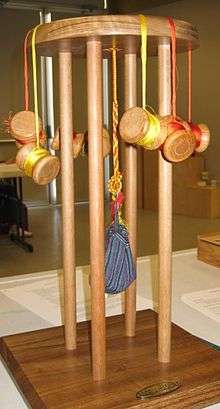Kumihimo

Kumihimo is a Japanese form of braid-making. Cords and ribbons are made by interlacing strands. Kumi himo is Japanese for "gathered threads".

History
Kumihimo cord was first created by a form of finger-loop braiding. Later tools such as the marudai and the takadai were employed to make more complex braids in shorter time. The most prominent historical use of the cords was by samurai as both a functional and decorative way to lace their lamellar armour and their horses' armor (barding). Kumihimo cords are now used as ties on haori jackets and obijime, which are used for tying on an obi (kimono sash).
A modern kumihimo disk made of firm but flexible foam plastic with notches can also be used as a portable marudai. The disks have 32 notches that create the tension that is usually created by tama on a marudai. The disks are convenient but are not as versatile as the marudai. On a marudai, any thickness or amount of string can be used, but on a disk only 32 or fewer strand braids can be made from thin cord. Also, marudai can make many types of braids, such as flat, four sided, and hollow. There are also rectangular foam cards, especially suitable for making flat braids.
The foam kumihimo disk is lightweight, portable, and significantly more affordable than the traditional marudai. Braiders can create complex braids up to 24 bobbins and incorporate beads. There are many sizes and shapes of foam disks available. Look for a disk that is sturdy and doesn't bend easily, otherwise the braider will experience uneven tension.
Related terms
- Kagami – the top braiding surface on a marudai; Japanese for "mirror."
- Kongō Gumi – a class of patterns for round cord all involving eight threads folded in half for a total of sixteen strands. In clockwise order, each bobbin is moved to the opposite side. When different combinations of thread color are used, many interesting patterns emerge, including diagonal stripes, diamonds on a background, triangles resembling hearts, and tiny six-petalled flowers.
- Marudai or maru dai – the frame for the braiding; "maru dai" Japanese for "round stand."
- Obi – the broad cloth sash used in traditional dress; a kumihimo belt, called the obijime, is tied around the obi.
- Obijime – the cord used to bind the obi securely.
- Takadai – a rectangular or square frame for creating flat kumihimo, as opposed to the round kumihimo made by the marudai.
- Tama – bobbins. The thread is kept from unwinding by passing the thread under itself, forming a loop around the tama. True silk is a hollow fiber with a rough surface that resists slipping past the loop unless gently pulled. For synthetic fibers, a flexible plastic "clamshell" bobbin may be preferable.
See also
External links
- Talzhemir's introductory handouts, in .PDF format, including Kongo Gumi and a pattern for a notched cardboard wheel
- Instructions with diagrams
- Eight strand hollow braid over a core
- Kumihimo bracelet tutorials and more
- The official site of Kumihimo
